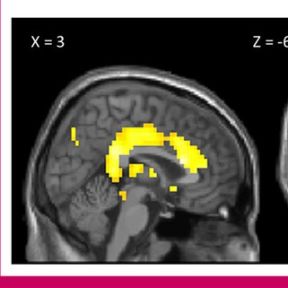NEUROSCIENCE- Sticks and Stones Break Your Bones But Words Hurt Your Brain. There's overlap in how the brain processes physical and emotional pain.

KEY POINT
- Pain processing is about detecting imminent damage.
- Words associated with physical pain can change the perception and brain processing of pain.
- Brain imaging shows that semantic pain partly shares the neural substrates of nociceptive pain.

When I was a kid my mom used to tell me, "Sticks and stones can break your bones, but words will never hurt you." She was riffing on a phrase from GF Northall in 1894 but she was also trying to tell me to ignore other kids in school who might say unkind things. She was trying to encourage resilience and mostly succeeded. But words seem to "hurt" also, even when no bones are broken.
Do Words Hurt?
Researcher Eleonora Borelli and her colleagues in Modena, Italy, were interested in similarities in the brain's processing of pain from physical injury and that from words. They extended prior work showing that processing "semantic pain" (e.g. words associated with physical pain) can change the perception and brain processing of pain. They also wanted to relate this to social pain, that "of social exclusion, rejection or loss of significant others."
In a cohort of 34 women, the researchers studied brain activity using fMRI in two sessions. The "semantic" session involved "positive words, negative pain-unrelated words, physical pain-related words, and social pain-related words." The "nociceptive" session related to bodily somatic pain involved mechanical activation of the skin that could be "painful" or non-painful. Each person subjectively rated how unpleasant each condition was.
When examining regional changes in brain activity, words in the semantic session associated with social pain led to increased activity in many of the same areas found for physical pain. The researchers concluded that their results confirm that "semantic pain partly shares the neural substrates of nociceptive pain."
There Is a Point to Pain
This doesn't mean that the neural processing of physical pain due to mechanical injury is exactly the same as that from words, but it does suggest that there is overlap. This results in related effects on how we feel.
This suggests something additional about pain processing. A fascinating thing about physical pain is that it's a brain-level interpretation of impending tissue damage detected by "nociceptors" relaying in the spinal cord. The point of nociceptive responses is to warn you that something damaging is about to happen or will happen if you keep doing what you're doing. If you accidentally put your hand too close to something very hot, nociceptors in your skin will activate to generate a reflex to pull your limb away before you get burned.
The key here is that the receptors help out before injury to prevent damage. This means that many detected events are avoided and don't lead to ongoing damage.
Changing the Threshold for Pain
I think how we react to pain from words can be related to bodily reactions to pain from mechanical inputs. Many of the things we hear and see that might be insulting or hurtful don't always have to be experienced at the level of "damage." That is, we can ignore and be resilient to some things by changing our threshold of reaction in the same way bodily reactions to non-damaging impacts are handled by the nervous system.
When framing the potential effects of words on how we feel in this way, we gain some agency over how they can affect us in the long term. It doesn't mean to ignore everything—and certainly not more serious injuries. I'm suggesting, though, that we can ignore some things, treating them how our brain treats the little bumps and bangs our bodies experience every day. Not everything that can be reacted to has to lead to lasting damage.
The most important takeaway for me is that this is another example of research clearly demonstrating the fallacy of separating the brain from the body. Humans, like all animals, are integrated, holistic beings. We can easily see a broken bone and infer the real extreme pain that the person must be experiencing. It's critical to realize that the injuries and pain that a person might have from social experiences are also real.
That old expression, often used to put down feelings, is apt—but for a different reason. It really is "all in your head," but so is the entire universe. All of our experiences, regardless of point of origin, are in our heads. That's the point of being conscious.
It doesn't matter whether our brains get information from our skin, our ears, our eyes, or our thoughts; hurtful intentions can cause pain. While my mom wasn't completely correct in using that old saying, her intentions were always helpful and did help manage hurt.
- Questions and Answers
- Opinion
- Story/Motivational/Inspiring
- Technology
- Art
- Causes
- Crafts
- Dance
- Drinks
- Film/Movie
- Fitness
- Food
- Spellen
- Gardening
- Health
- Home
- Literature
- Music
- Networking
- Other
- Party
- Religion
- Shopping
- Sports
- Theater
- Wellness
- News
- Culture
- War machines and policy

